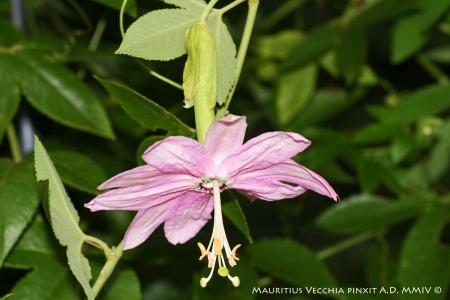
SUBGENUS: passiflora
SUPERSECTION: tacsonia
SECTION: elkea
GEOGRAPHICAL DISTRIBUTION OR ORIGIN:
Venezuela, Colombia, Peru, Bolivia.
MINIMUM TEMPERATURE: 2 °C
IDEAL MINIMUM TEMPERATURE: 5 °C
SYNONYMS: P. tripartita var. mollissima (Juss.) Poir., P. psilantha (Sodiro) Killip, P. tomentosa var. mollissima (Kunth) Triana & Planch.
ETYMOLOGY: The term mollissima (Latino mollissimus, soft, tender) refers to the flexible and elastic stems.
NOTES: Chromosomes: 2n=18
DESCRIPTION:
Passiflora mollissima is also known by the synonym P. tripartita var. mollissima. However, both Killip and John Vanderplank himself classify the two species (P. tripartita and P. mollissima) as different. Surely, one day, a solution to the dilemma will be found.
However, it is a beautiful plant with graceful deep pink pendulous flowers and flavourful fruit, valued and in great demand by collectors. It is also very hardy (minimum winter temperature 2°C, with remarkable adaptability), meaning it can bloom and bear fruit in open ground in many Italian regions with a mild climate, including with appropriate protection in olive-growing areas and in citrus-growing areas. Being of Andean origin (Colombia, Venezuela, Peru and Bolivia where it lives at altitudes ranging from 2000 to over 3200 m) it cannot bear the high temperatures of central-southern Italy in summer; here, however, it is possible to cultivate it on the cooler hilly areas, possibly planting it in the shade of some trees. It prefers well-drained, slightly sandy soil.
The leaves of this plant, which are 12 cm long and 15 cm wide, are trilobate, with narrow sinuses and tightly serrated margins. The leaf blade is pubescent. The apices of the lobes are pointed. The leaf petiole has 4 to 6 pairs of asymmetrical glands.
Its flowers are those typical of the subgenus Tacsonia, with a tubular calyx up to 8 cm long. They have a corolla of 9-10 cm in diameter, composed of hooked sepals and petals of a beautiful pink. They are slightly closed, a detail that imparts their elegance. The small corona is purple with pink tubercles. From the corolla emerges the long white androgynophore, embellished by the intense yellow of the pollen deposited on the anthers.
The fruits, yellow when ripe, are edible, have a pleasant flavour and are sold commercially. Due to their elongated, narrow shape (10 cm in length x 3.5 cm in diameter), this passionflower is called 'The Banana Passion Flower' and is usually cited in the literature with this name.
The P. mollissima is distinguished from P. tarminiana because the sepals and petals are not retroflexed or perpendicular to the floral axis, but not completely open and shorter. Furthermore, it has larger and more persistent stipules, while in P. tarminiana they are small and deciduous.
It is easy to cultivate in a pot, but only well-grown and stabilised specimens will bloom after a few years of patience, followed by repotting in pots of up to 35-40 cm in diameter.
Propagation
is easy from cuttings and reproduction from seed.